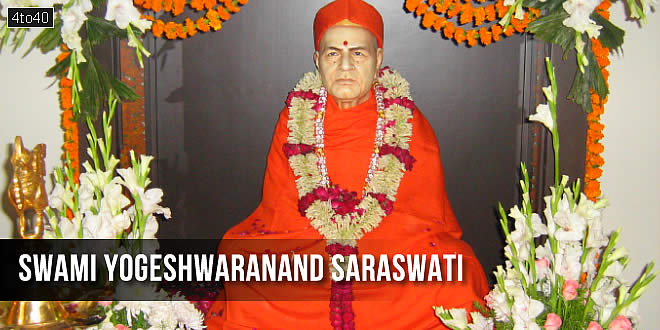Swami Yogeshwaranand Saraswati was counted amongst the most popular as well as most learned Yogis of the 20th century. His life, which was spent mostly in the Himalayas, is the perfect example of extreme renunciation and asceticism. Yogeshwaranand devoted himself completely towards the realization of the soul and God. He was a major proponent of yoga and aimed at reviving the ancient science. With this biography, you will be able to know more about Swami Yogeshwaranand Paramahansa.
Swami Yogeshwaranand Paramahans was one of the greatest Yogis of the 20th century. He lived the life of extreme renunciation and austerity mostly in the Himalayas practicing all that is laid down in the scriptures for the realization of soul and God and spent a life time in reviving the ancient science of Yoga.
Swami Yogeshwaranand Parmahans formerly known as Brahmachari Vyas Dev ji, left his home of his well-to-do parents at a tender age of twelve, like Buddha, in search of knowledge and self-realization. The young Brahmachari spent the early years of his life in the study of Sanskrit language and mastering the scriptural lore. He then followed the path of ancient rishis of Himalayas and practiced the most difficult tapasya and Yogic Sadhana while continuing the search of real guru who could lead him to the final goal. He came across a number of ascetics about whom one reads only in the scriptures but his search for a real guru was rewarded with the meeting of a great ascetic, yogi Paramananda Avadhoot, who helped him in perfecting shunya (void) samadhi. Later, his search for a great yogi came to an end only when he met Avadhoot Swami Atmanand ji (who had then returned from Tibet) in a cave near Gangotri (in Himalayas) from whom he learnt Samprajnata samadhi and perception of various processes of nature in the state of samadhi, the ultimate divine knowledge.
Swami Yogeshwaranand Saraswati Life History:
Swami Yogeshwaranand Saraswati was formerly known as Brahmachari Vyas Deva Ji. He was born in 1887. He left his home at the tender age of fourteen in search of knowledge and self-realisation. The young brahmachari spent the early years of his life in the study of Sanskrit and mastering the scriptural lore. He then followed the path of the ancient Rishis of the Himalayas and practised the most difficult tapasya and yogic sadhana while continuing the search of a real guru who could lead him to the final goal. He came across a number of ascetics about who one reads only in the scriptures, but his search came to an end only when he met Avadhuta Swami Atmananda Ji, who had then returned from Tibet.
By constant and dedicated practice of meditation he experienced various types of Samadhi, some of them lasting for several days, which culminated in his gaining knowledge of self-realisation, origin and dissolution of cosmos and the goal of human existence. At the request of his guru, he wrote down the esoteric knowledge, which used to pass from guru to disciple through personal relationship and which sometimes required not only a whole lifetime, but several lives, in a series of books.
Swami Yogeshwaranand Saraswati Ji never accepted anything before he had experienced it himself. As Abu Hamid al Ghazali (1058-1152) once said, “Reason is God’s scale on earth.” His willpower was extremely strong. A given word could not be broken. To him, it was as well holy as a rule of life. He once said about himself: “I am as soft as a flower, but as hard as a rock.” He taught Yoga in the traditional way: rather by silence and concentration than by verbal teaching. Which does not remove the fact that he wrote several books.
As a preparation to meditation Swamiji also practised and perfected Hatha Yoga. On the basis of his practice and the classical literature, he has devised about four hundred asanas and sixty pranayamas, which have been explained in his book “Bahiranga Yoga” (First Steps to Higher Yoga). Most of the yoga enthusiasts, particularly in the West, perhaps know only this part of Yoga, which in fact is only a means to higher yoga.
Swami Yogeshwaranand Saraswati was born as Brahmachari Vyas Dev ji, to extremely rich parents. However, he left his home at the tender age of twelve, in search of knowledge and self-realization. His entire youth was spent in studying Sanskrit language and mastering the scriptural knowledge. Some time later, he went to the Himalayas and practiced the most difficult tapasya and yogic sadhana. All the while, he was in the search of a guru, who could help him in attaining his goal.
In the process, he came across Yogi Paramananda Avadhoot, a great ascetic who helped him in perfecting shunya (void) samadhi. However, his search for a real guru ended when he met Avadhoot Swami Atmanand ji in a cave near Gangotri (in Himalayas). From Atmanand ji, he got to learn Samprajnata samadhi and awareness of various processes of nature in the state of samadhi, the ultimate divine knowledge. Throughout his life, he kept meeting great ascetics, learned from them and attained higher stages in yoga and meditation.
Some of the Samadhis of Swami Yogeshwaranand Saraswati lasted for several weeks. In the end, he used to wake up with advanced knowledge of self-realization, origin & conclusion of cosmos and the objective of human existence. Throughout his life, he imparted his knowledge to people belonging to different faiths as well as different countries. Swami Yogeshwaranand Paramahansa also traveled abroad to spread knowledge. He breathed his last on 23rd April 1985, at the age of ninety-nine.
The various events of his life in the Himalayas with the great ascetics and the practice of higher yoga are far stranger than fiction. Some of them are even unbelievable for those who are not conversant with the power of yoga. One of the events of the great yogi’s life is described in his own words as “He placed his gracious hand on my head. My eyes closed and I attained some unknown state. My body was illuminated as if by electric light. This light filled the entire body and revealed all its inner states, of subtle processes.”
By constant and dedicated practice of meditation he experienced various types of Samadhis, some of them lasting for several weeks which culminated in his gaining knowledge of self-realization, origin and dissolution of cosmos and the goal of human existence. Having satisfied his thirst for the ultimate divine knowledge, he spent the rest of his life imparting the valuable knowledge to hundreds of thousands of keen aspirants of all faiths from many countries of the world. He travelled widely out of India.
He merged in Brahma on April 23, 1985 at the age of ninety-nine. The esoteric knowledge which used to pass from guru to disciple through personal relationship and which sometimes required not only a whole lifetime but several lives, was set down, at the behest of his guru, in his books. Some day, when the top scientists of the world pay the attention it deserves, to this subtlest of subtle sciences, these books will give all the basic material for their research and cause a stir in the world of science. At present, these books are helping keen aspirants everywhere to achieve their ultimate goal of realization of soul and God.
Since the time of his realisation, Swamiji devoted himself to imparting the invaluable knowledge gained by him to aspirants in India and abroad. He established ashrams at Gangotri (near the source of the River Ganga), at Uttarkashi (a little lower down on the bank of the Ganga), at Rishikesh (where the Ganga leaves the mountains) and at Pahalgam (altitude 7500′) in Kashmir – where I had the good fortune to stay for three weeks in 1975. There is also an ashram at Delhi, established in 1978, mainly for the publication of Swamiji’s books and to serve his many disciples in Delhi and nearby areas. To spread his knowledge, Swami Yogeshwarananda went round the world three times. In May 1973 he stayed for a week in our residence. He addressed the pupils of our Yogaschool and at their request, demonstrated some asanas. He was 86 at that time, but rest assured not a few of our pupils felt they had still a long way to go!
He passed into mahasamadhi on 23rd April 1985.
 Kids Portal For Parents India Kids Network
Kids Portal For Parents India Kids Network







